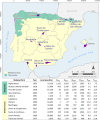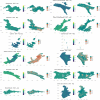Long-term vegetation dynamics in Spain's National Park Network: insights from remote sensing data
- PMID: 40533684
- PMCID: PMC12176930
- DOI: 10.1007/s10661-025-14233-w
Long-term vegetation dynamics in Spain's National Park Network: insights from remote sensing data
Abstract
Understanding long-term vegetation dynamics in protected areas is crucial for assessing ecosystem resilience and informing adaptive management strategies. This study presents a comprehensive analysis of vegetation trends across Spain's National Park Network from 1984 to 2023, using Landsat imagery processed in Google Earth Engine. Twelve national parks, representing diverse biogeographical regions and ecosystems, were analyzed using vegetation indices such as NDVI, SAVI, kNDVI, and NDMI. The Mann-Kendall test and Theil-Sen slope estimator were employed to detect monotonic trends and quantify their magnitudes, respectively. Our results reveal a predominant increase in vegetation activity across most parks over the past four decades, though with notable spatial and seasonal variations influenced by topographic gradients, bioclimatic zones, and vegetation types. High-altitude parks exhibited strong seasonal dynamics, with positive trends concentrated during the growing season, whereas Mediterranean parks showed more consistent trends throughout the year. Conversely, wetland parks like Las Tablas de Daimiel displayed concerning negative trends, highlighting ecosystem vulnerabilities associated with hydrological stress. These findings underscore the importance of integrating high-resolution remote sensing data into long-term ecological monitoring programs to track ecosystem functioning and assess management practices in protected areas. Combining remote sensing with field observations is essential to support evidence-based conservation strategies in response to climate change and other anthropogenic pressures.
Keywords: Conservation management; Environmental monitoring; Forest expansion; Landscape dynamics; Protected areas; Spatiotemporal trends.
© 2025. The Author(s).
Conflict of interest statement
Declarations. Ethics approval: All authors have read, understood, and have complied as applicable with the statement on “Ethical responsibilities of Authors” as found in the Instructions for Authors. Competing interests: The authors declare no competing interests.
Figures











References
-
- Adell-Michavila, M., Vicente-Serrano, S. M., Montorio Llovería, R., Cai, Z., & Eklundh, L. (2024). Analysis of plant phenology dynamics in Spain from 1983 to 2020 using satellite imagery. Cuadernos de Investigación Geográfica,50(1), 145–178. 10.18172/cig.5739
-
- Aklilu Tesfaye, A., & Gessesse Awoke, B. (2021). Evaluation of the saturation property of vegetation indices derived from sentinel-2 in mixed crop-forest ecosystem. Spatial Information Research,29(1), 109–121. 10.1007/s41324-020-00339-5
-
- Alados, C. L., Komac, B., Bueno, C. G., Gartzia, M., Escós, J., Gómez García, D., et al. (2011). Modelización de la matorralización de los pastos del Parque Nacional de Ordesa y Monte Perdido y su relación con el cambio global. In L. Ramírez and B. Asensio (Eds.), Proyectos de investigación en parques nacionales: 2007–2010 (pp. 101–121). Organismo Autónomo de Parques Nacionales, Ministerio de Medio Ambiente y Medio Rural y Marino.
-
- Alcaraz-Segura, D., Baldi, G., Durante, P., & Garbulsky, M. (2008a). Análisis de la dinámica temporal del NDVI en áreas protegidas: Tres casos de estudio a distintas escalas espaciales, temporales y de gestión. Ecosistemas,17(3).
-
- Alcaraz-Segura, D., Cabello, J., Paruelo, J. M., & Delibes, M. (2008b). Trends in the surface vegetation dynamics of the national parks of Spain as observed by satellite sensors. Applied Vegetation Science,11(4), 431–440. 10.3170/2008-7-18522
MeSH terms
Grants and funding
LinkOut - more resources
Full Text Sources
Research Materials
Miscellaneous

